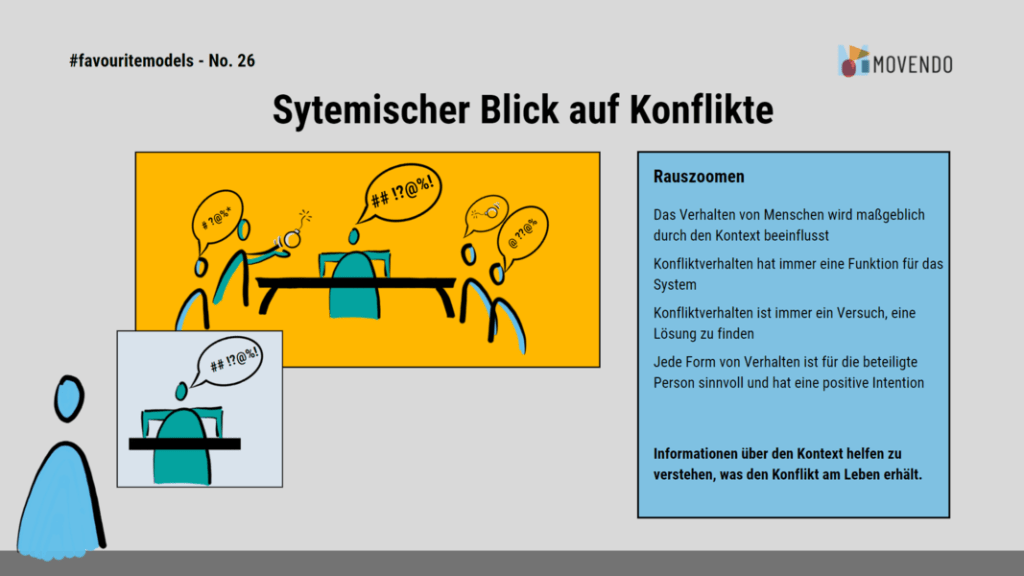Created by Susanne Stock
#favouritemodels No. 26 – Systemic perspective on conflicts

How can my colleague behave in such an impossible way? He’s upsetting the whole team!
When conflicts arise in a team, it is easy for us to lose sight of the individual behavior of others. They seem irrational, no longer purposeful, sometimes even malicious. Our first impulse is often to look for the supposed “solution” or the core of the problem in the person: “Maybe my colleague is trying to annoy us?” “He must have a hidden agenda” or “There’s something wrong with him.”
Personal attributions are of course one way of understanding the conflict. However, they often don’t really help us to make any progress and tend to exacerbate it. It is quite possible that we simply “write off” certain people at some point and no longer give them the opportunity to explain themselves or see their strengths.
The systemic perspective on conflicts shows us another way.
The aim here is not to narrow the view and only look at the person, but rather to broaden the view and look at the entire context of the conflict. From this perspective, questions such as “How do I explain the occurrence of a conflict?” and “What intervention would be possible and useful to support the resolution of the conflict?” arise. The answers to these questions can be very diverse, as they depend on the individual understanding of a conflict. For example, it makes a significant difference whether a manager asks “What does this conflict stand for?” or “Who is at fault?”. The second question tends to reduce the conflict to the individual characteristics of the alleged aggressor. The question “What does this conflict stand for?”, on the other hand, means analyzing the situation as neutrally as possible in its overall context and exploring the actions, backgrounds and motives of all those involved in their interactions. The conflict thus presents itself more as a response – albeit not a constructive one – to a current situation between the parties involved. Perhaps it simply appears to be the only option they can see at the moment. The conflict could therefore also be used as a trigger for change. Because wherever observers with their different constructions of reality meet, conflicts are inevitable. It can also be said that conflicts are part of life and are not exclusively terrible – they can also be highly fruitful. When dealing with conflicts, it is a question of individual assessment as to which side of this ambivalence is emphasized. A systemic approach opens up a wide range of scope for effective and creative action (not only) by managers.
Important questions in this approach
How does the overall context (in the organization/team) trigger and stabilize the conflictual behaviour?
Example: A new colleague in the team is given a big leap of faith by her boss and is tasked with modernizing the product portfolio and making it fit for the future. The previous product manager was not involved in this decision and there was no official announcement in the department about the new division of roles. From then on, the new colleague regularly receives nasty emails from the product manager and is kept out of important meetings. this example shows that unclear communication and a lack of leadership behavior trigger the conflict and maintain it in the long term. With a focus on the “question of guilt”, however, the perception is that the product manager is difficult. So close to retirement, you no longer want to seek a resolving conversation with him, so you simply endure the situation and avoid the product manager as much as possible (which further stabilizes the conflict).

What is the function of this conflict? What does it stand for?
In our example, the conflict stands for an unclear distribution of roles. At the same time, important principles of teamwork have not been clarified: How do we ensure that our products are future-proof? How do we ensure a transfer of knowledge between the different generations? How do we deal openly with conflicts within the team? The fact that a colleague suddenly intervenes in his area of work leads to the experienced product manager feeling that he has to “defend himself”. However, as conflicts in the team are not discussed openly, he uses means that appear quite “aggressive” to the others and lead to the conflict being perceived more as a personal feud between him and the new colleague.
When I recognize the systemic context of a conflict, it is often easier for everyone involved to develop solutions to the conflict. Looking away from the individual towards the context can calm heated tempers and promote a more objective view of the conflict. In the end, it is no longer about changing “the difficult colleague”, but rather about creating a context in which roles are clarified and employees are able to develop principles of cooperation within a safe framework.
How does my favoritemodel help you?
I recently used the systemic perspective on conflicts in a team workshop. There was quite a lot of resentment in the team due to the dominant behavior of the manager. The systemic perspective helped the team to get away from the blame game and think more about how the highly regulated corporate context triggers the behavior. It was also interesting to realize that the behavior of the team members also perpetuated the dominance of the boss. In many discussions, the team members tended to sit back and let the boss get on with it. Displeasure about the situation was only discussed with trusted colleagues, but never openly within the team. This further stabilized the manager’s behaviour. Thanks to this insight and new rules of conduct in the team, everyone involved can now deal with the situation better. The manager is working on really handing things over and delegating and the team members are working on talking openly about their wishes for more self-determined work.
Some reflection questions for the systemic perspective on conflict resolution are:
- What are the possible causes of the conflict?
- What possible meaning, what function does the conflict have for those involved?
- What behavior contributes to maintaining the state of conflict?
- How can the pattern of behavior be interrupted or replaced by other behavior?
- What do we agree on if we fall back into old patterns?
Author

Susanne Stock
Project partner




